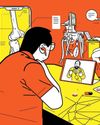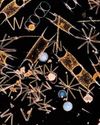
Every day, thousands of Mumbaikars make their way through the Masjid station in the Masjid Bunder area of South Mumbai on the Central and Harbour lines of the city’s local trains,but most are perhaps unaware that Masjid does not refer to a mosque, but the Shaar Harahamim Synagogue. It is located a stone’s throw from the station and is locally referred to as Juni Masjid.
Shaar Harahamim Synagogue dates back to 1796 and is the oldest in Mumbai. It can be reached through a network of complex lanes and bylanes from Yusuf Meher Ali Road, on the other side of which another maze of lanes leads to Israel Mohalla, where stands the Share Rason Synagogue, the city’s second-oldest. Both the synagogues are housed in small buildings, with simple prayer halls.
Shaar Harahamim (meaning ‘Gate of Mercy’) was built by Samuel Ezekiel Divekar, a Bene Israel Jew. He was part of the Bombay Presidency’s army, which fought Tipu Sultan in the Second Mysore War (1780-84). Divekar was captured by Tipu’s army, and was sentenced to death. He, however, survived because of an intervention by Tipu’s mother when she learnt he was a Jew, who she considered to be ‘God’s chosen people’. While a prisoner, Divekar vowed to build a synagogue in Bombay after his release, and he kept this promise, building Bombay’s first synagogue for the Bene Israel Jewish community. In the 1850s, the old synagogue was demolished to make way for the current larger one.
Bu hikaye Forbes India dergisinin October 9, 2020 sayısından alınmıştır.
Start your 7-day Magzter GOLD free trial to access thousands of curated premium stories, and 9,000+ magazines and newspapers.
Already a subscriber ? Giriş Yap
Bu hikaye Forbes India dergisinin October 9, 2020 sayısından alınmıştır.
Start your 7-day Magzter GOLD free trial to access thousands of curated premium stories, and 9,000+ magazines and newspapers.
Already a subscriber? Giriş Yap

Home-Cooked Meal Is Now Greatly Valued
The pandemic has also brought with it an improved focus on hygiene, use of technology in dining, rise of cloud kitchens and resurgence in popularity of Indian ingredients

Paytm 3.0 - Reaching Near Breakeven In Two Years
As of 2020, Vijay Shekhar Sharma’s super app for financial services had run up losses in thousands of crores. Now, as digital payments gets yet another boost courtesy Covid-19, he’s hopeful of reaching near breakeven in two years

THE PANDEMIC HAS CAUSED WOMEN GREATER LABOUR PAIN
Covid-19 has shown that women are more likely to face the brunt of job losses than men, and find fewer opportunities when they want to resume. That apart, several have to deal with increased hours of unpaid work at home and even domestic abuse

LEADERSHIP WILL BE ABOUT SEEING THE BIGGER PICTURE
Leaders must not only guard their teams first during a crisis, but also deal with stakeholders with respect and dignity. And apart from pursuing business goals, they should remain committed to our planet and the environment

PHILANTHROPY SHOULD BE HUMBLE, BUT NOT MODEST
Apart from building a flexible and resilient framework for the future, philanthropists, civil society and the government must work in tandem so that every rupee is absorbed on the ground

INTEGRATED HEALTH CARE, TECH WILL DISRUPT SECTOR
While clinical research will get a boost, having a skilled workforce and public spending on health care will be challenges in the near term

DIGITALISATION WILL HELP IN VALUE CREATION
As the pandemic brings technology and innovation to the core of business and daily life, the next decade will see about 150 million digital-first families in India

Industry 4.0: Climate Revolution?
Augmenting sustainability alongside digital capabilities is an economic, competitive and global opportunity for India’s businesses, but regulations need to reflect intent

EV Dream Still Miles Away
Electric vehicles have remained a buzzword in India for years. But not much has moved on ground due to high upfront costs, range anxiety and charging infrastructure

Living Waters
A virus has caused us to scramble for oxygen but our chokehold on the environment is slowly strangling the very waters that breathe life into us. The virus is a timely reminder: We are merely consumers, not producers of life’s breath on this planet